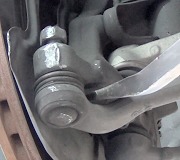Are you sure you want to tackle this job? First of all, it's very rare to have even one worn ball joint at 75,000 miles. That would be very common on a Chevy Blazer, but not on a Durango. It is normal to have a lot of vertical free play in the two upper joints. That is not normal on other vehicles, but it is completely acceptable on Dakotas and Durangos. The replacement ball joints from the dealer will have the same movement.
Professionals use an air hammer to shear off the rivet heads on the upper ball joints and to push the rivets out. The same thing can be done with an angle grinder and a drill but expect it to take a couple of hours. You'll need a ball joint press to remove and install the lower ball joints.
The service manual should be used to learn where to jack up the vehicle to prevent spring pressure from making it impossible to separate the tapered studs and to prevent parts from flying apart. When the brake calipers are removed, be sure to tie them up with hooks or wire. To prevent damage, they must not be allowed to hang by their hoses.
The service manual will have warnings about how to inspect the tapered holes in the spindle for wear or damage. The tightness of the axle nuts are also very important to prevent damage to the wheel bearings.
You'll need a click-type torque wrench for the ball joint stud nuts and the lug nuts. Lug nut tightness is critical to prevent warping the rotors and damaging the studs. You'll need to have an alignment performed since you can't guarantee the upper joints will end up in the same location as the old ones.
Caradiodoc
Tuesday, February 16th, 2010 AT 5:29 AM



